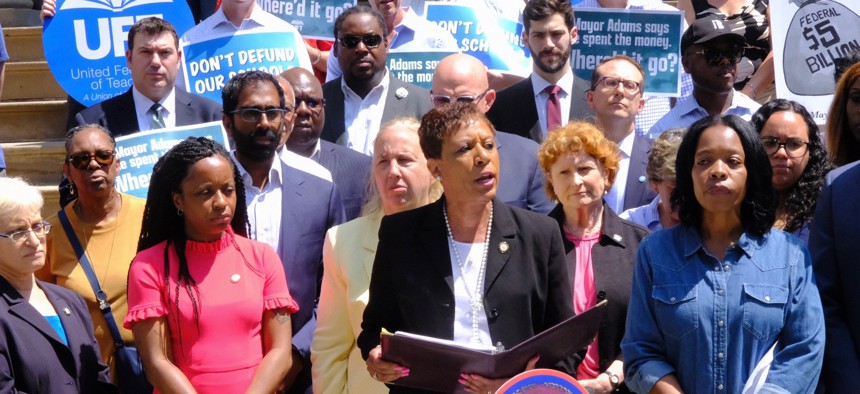New York City Council members blame Department of Education for budget mismanagement after cutting funding
New York City Council members said the Department of Education failed to anticipate cuts in line with declining enrollment, leaving principals “surprised” by dwindling budgets.

New York City Council Speaker Adrienne Adams Gerardo Romo/NYC Council Media Unit
New York City Council members and the Department of Education faced off in a debate over school budget cuts on Friday, with council members blaming the declining funding for some individual schools on budget mismanagement by the agency and a failure to retain students.
The city will increase its own investment in public schools in fiscal year 2023 by more than $700 million under the budget passed earlier this month, but funding for public schools, when accounting for state and federal funds, will dip by $215 million – out of the $31 billion Department of Education budget. Mayor Eric Adams said previously the cuts were in line with declining enrollment, which has dipped by 120,000 students over the past five years, according to the department.
School funding became a last minute sticking point in budget negotiations between the City Council and the mayor’s office, after the teachers union and student advocates raised the alarm. But Mayor Adams resisted further increases to the DOE budget, and the council conceded, with a promise to adjust the budget midyear to minimize the cuts to schools once Fall enrollment numbers were available. Some progressive council members who voted against the spending plan attributed their “no” votes, in part, to the cuts. Friday’s hearing came less than two weeks after the council voted to approve the fiscal year 2023 budget, and a week before the current fiscal year ends. The council justified the hearing as holding DOE’s feet to the fire on spending.
When the money is doled out to individual schools, some will see year-over-year budget increases – but others will see notable cuts. And the decreased funding has sent principals into a “panic” about how they will pay to retain teachers and hire new ones in order to meet smaller class size goals mandated by the state Legislature, Council Member Gale Brewer, who chairs the oversight and investigations committee, said during a joint hearing with the education committee on Friday.
“I’ve been around a long time. I haven’t heard this kind of panic before,” Brewer said. “It’s a mess, and it has not been like this in the past.”
Council Speaker Adrienne Adams defended the city’s school funding allocation, and said the city portion of the fiscal year 2023 school funding allocation is “the highest level that our city’s history has ever seen.”
“Yet some of our individual and local schools are facing budgets that are drastically different for the next school year,” she said. “And let me be perfectly clear – that is a DOE-determined decision.”
Council members said the agency should have anticipated the cuts and consulted with individual principals before making the spending allocations, yet many school leaders were “surprised” by slashed funding.
“It sounds like you’re learning along with the rest of us, along with teachers, what the situation is instead of proactively looking to engage them,” Adams said. “It sounds like in a lot of cases, my district included, that these are total surprises to my educators and principals in the school.”
Education department officials blamed the reduction on declining federal stimulus money, much of which has already been committed to pay for post-pandemic opening costs, expanded initiatives including a summer youth program and early childhood education, along with the Community Schools program.
First Deputy Chancellor Daniel Weisberg said the commitments have left the department with just $160 million, of $1.8 billion in total federal stimulus funding for fiscal year 2023, to help “cushion” schools whose budgets will be slashed.
“As everybody here today knows, that funding is going away over the next two years, and it’ll be completely gone by fiscal year 2025,” he said. “Of course, schools that have seen precipitous enrollment declines are facing some really tough decisions as schools in that situation always have, including pre-pandemic.”

